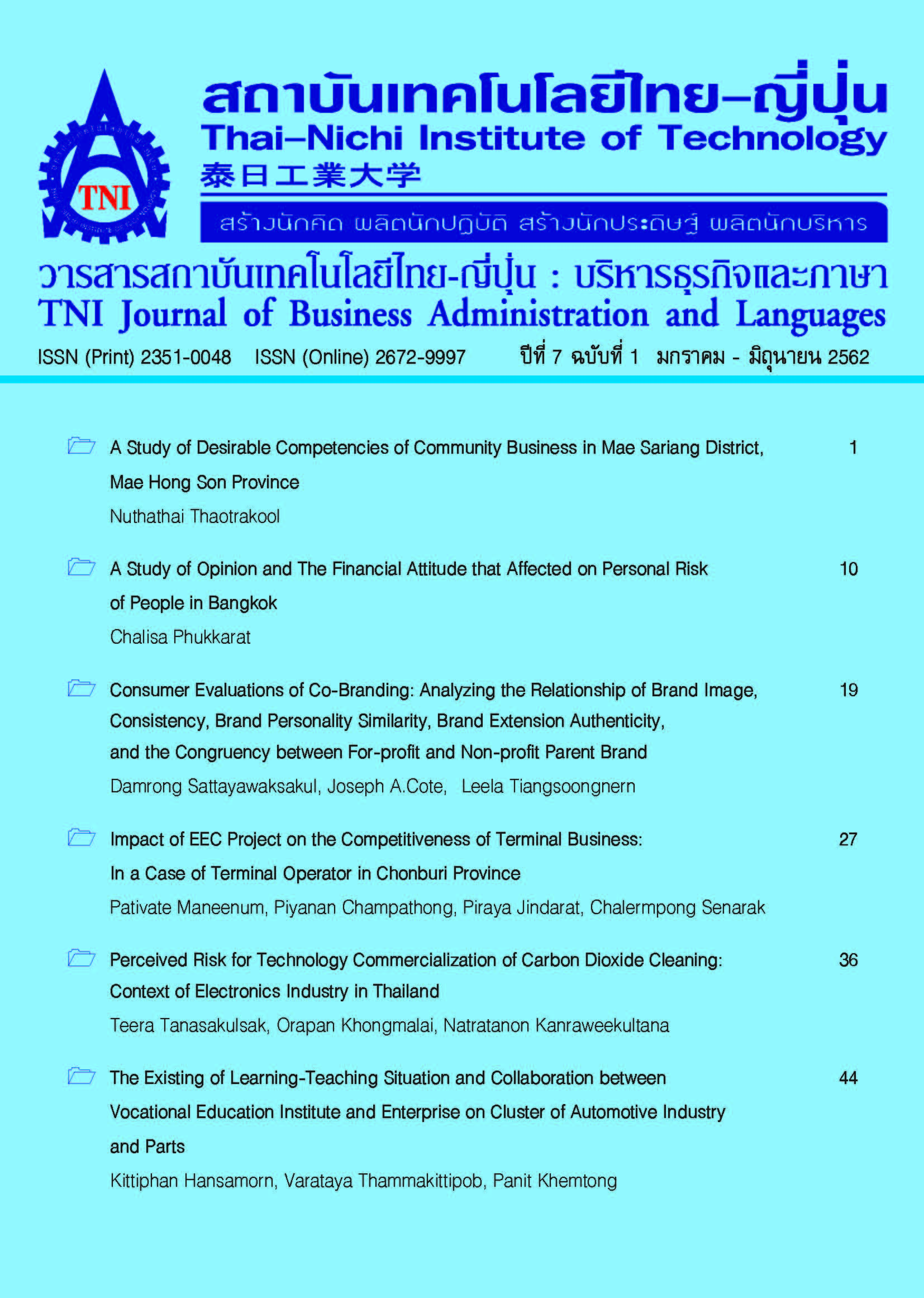Perceived Risk for Technology Commercialization of Carbon Dioxide Cleaning: Context of Electronics Industry in Thailand
Main Article Content
Abstract
The purposes of this study were to identify risk factors affecting commercialization of carbon dioxide cleaning technology to Thailand’s electronics industry to develop the appropriate risk response as well as marketing strategy for each electronics organization. The research methodology composes of qualitative and quantitative techniques. In-depth interviews and observation were performed for identifying the relevant risk factors. Quantitative research techniques are used to assess risk levels. We empirically test whether risk factors affect the commercializing performance of Carbon dioxide cleaning technology using survey data from Electronics firms in Thailand. Exploratory Factor Analysis technique (EFA) is applied for risk factor analysis. The results show as following 1. Organization that using CO2 cleaning, risk factors comprised of project reference, maintenance complexity and technology safety. 2. Organization that used to evaluate but not using CO2 cleaning, risk factors comprised of technology safety, technology compatibility & safety, technology complexity and comparative advantage. 3. Organization that not using CO2 cleaning, risk factors comprised of comparative advantage, technology efficiency & compatibility, technology complexity and technology safety & compatibility
Article Details
Article Accepting Policy
The editorial board of Thai-Nichi Institute of Technology is pleased to receive articles from lecturers and experts in the fields of business administration, languages, engineering and technology written in Thai or English. The academic work submitted for publication must not be published in any other publication before and must not be under consideration of other journal submissions. Therefore, those interested in participating in the dissemination of work and knowledge can submit their article to the editorial board for further submission to the screening committee to consider publishing in the journal. The articles that can be published include solely research articles. Interested persons can prepare their articles by reviewing recommendations for article authors.
Copyright infringement is solely the responsibility of the author(s) of the article. Articles that have been published must be screened and reviewed for quality from qualified experts approved by the editorial board.
The text that appears within each article published in this research journal is a personal opinion of each author, nothing related to Thai-Nichi Institute of Technology, and other faculty members in the institution in any way. Responsibilities and accuracy for the content of each article are owned by each author. If there is any mistake, each author will be responsible for his/her own article(s).
The editorial board reserves the right not to bring any content, views or comments of articles in the Journal of Thai-Nichi Institute of Technology to publish before receiving permission from the authorized author(s) in writing. The published work is the copyright of the Journal of Thai-Nichi Institute of Technology.
References
M. H. Morris, and D.F. Kuratko, Corporate entrepreneurship, Ohio: South-Western College, 2002.
S. Jantzen, T. Decarreaux, M. Stein, K. Kniel, and A. Dietzel, “CO2 snow cleaning of miniaturized parts,” Precision Engineering, vol. 52, pp. 122–129, Apr. 2018.
Electrical and Electronics Institute, Export and Production Index in Thailand’s Electronics Industry 2017. Bangkok: Electrical and Electronics Institute, 2017.
G. Castellion, and S. K. Markham, “Perspective: New Product Failure Rates: Influence of Argumentum ad Populum and Self-Interest,” Journal of Product Innovation Management, vol. 30, no. 5, pp. 976–979, 2013.
L. G. Tornatzky, M. Fleischer, and A. K. Chakrabarti, The processes of technological innovation. Lexington, Mass.: Lexington Books, 1990
J. Wei, P. B. Lowry, and S. Seedorf, “The assimilation of RFID technology by Chinese companies: A technology diffusion perspective,” Information & Management, vol. 52, no. 6, pp. 628–642, Sep. 2015
A. Y. L. Chong and F. T. S. Chan, “Structural equation modeling for multi-stage analysis on Radio Frequency Identification (RFID) diffusion in the health care industry,” Expert Systems with Applications, vol. 39, no. 10, pp.8645–8654, Aug. 2012.
M. G. Aboelmaged, “Predicting e-readiness at firm-level: An analysis of technological, organizational and environmental (TOE) effects on e-maintenance readiness in manufacturing firms,” International Journal of Information Management, vol. 34, no. 5, pp. 639–651, Oct. 2014.
K. b. Saji, and S. Shekhar Mishra, “Investigating the role of firm resources and environmental variables in new product commercialization,” Journal of Product & Brand Management, vol. 22, no. 1, pp. 18–29, Feb. 2013.
M. Crawford, and A. Di Benedetto, New Product Management, 8th ed. New York: McGraw Hill, 2006.
A. Balbontin, B. B. Yazdani, R. Cooper, and W. E. Souder, “New product development practices in American and British firms,” Technovation, vol.20, no. 5, pp. 257–274, May 2000.
C.-J. Chen, C.-C. Chang, and S.-W. Hung, “Influences of Technological Attributes and Environmental Factors on Technology Commercialization,” Journal Bus Ethics, vol. 104, no. 4, pp. 525–535, Dec. 2011.
K. Chan-H, and K. Chang-R, “Success and Failure Factors of Technology Commercialization: A Korean Case,” Asian Journal of Innovation and Policy, Vol. 3, pp. 25-49, 2014.
A. Okhongmalai and A. Distanont, Research Techniques in Technology and Innovation Management, Bangkok: Thammasat University, 2018
L. Petchroj and A. Chamniprasart, Research Methodology. Bangkok: Pimdee, 2002.
Lee J. Cronbach, Essential of Psychology Testing, 3rd ed. New York: Harper and Row, 1970.
T. Yamane, Statistics: An Introductory Analysis, 3rd ed. New York: Harper and Row, 1973
K. Vanichbuncha, Statistics for Research, 6th ed. Bangkok: Chulalongkron University, 2011.
J. F. Hair, R. L. Tatham, R. E. Anderson, and W. Black, Multivariate Data Analysis, 5th ed. Upper Saddle River, N.J: Prentice Hall, 1998.
C. Lundgren, A. Skoogh, and J. Bokrantz, “Quantifying the Effects of Maintenance – a Literature Review of Maintenance Models,” Procedia CIRP, vol. 72, pp. 1305–1310, Jan. 2018.
V. Alviarez, “Multinational production and comparative advantage,” Journal of International Economics, vol. 119, pp. 1–54, Jul. 2019.


